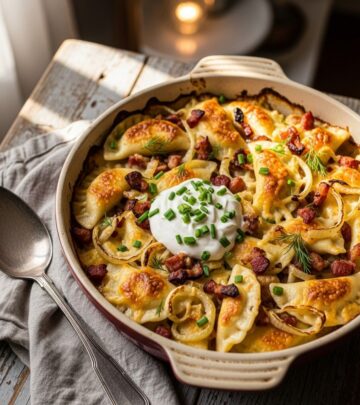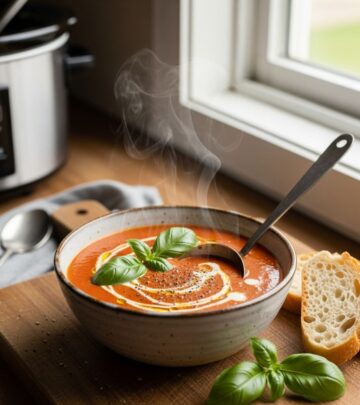Vintage Better Homes and Gardens Banana Bread Recipe: A Timeless Classic
Experience the nostalgia and warmth of homemade banana bread with this cherished vintage Better Homes and Gardens recipe.

Vintage Better Homes and Gardens Banana Bread Recipe
The Better Homes and Gardens banana bread from 1963 remains a staple in kitchens, capturing the charm of classic American baking. This easy and delightful recipe celebrates simplicity and the heartwarming effect of homemade treats, offering the perfect solution for using overripe bananas.
Baking this banana bread transports you to an era of cozy porches, family breakfasts, and the comforting aroma of freshly baked goods. Whether you’re new to vintage baking or reviving cherished memories, this guide covers every detail for authentic results.
Recipe Overview
- Prep Time: 10 minutes
- Cook Time: 45-55 minutes
- Resting Time: 15-20 minutes
- Yield: 1 standard loaf
- Difficulty: Easy
Ingredients List
This banana bread uses minimal ingredients, making it practical for quick baking sessions and utilizing pantry staples.
- 1/3 cup shortening (butter may be substituted)
- 1/2 cup sugar
- 2 large eggs
- 1 3/4 cups all-purpose flour
- 1 teaspoon baking powder
- 1/2 teaspoon baking soda
- 1/2 teaspoon salt
- 3 medium extra-ripe bananas
- 1/2 cup chopped walnuts (optional)
Step-by-Step Instructions
- Preheat your oven to 350°F (175°C).
- Cream together shortening (or butter) and sugar in an electric mixer until light and fluffy.
- Add eggs one at a time, mixing thoroughly after each addition.
- Sift the flour, baking powder, baking soda, and salt together in a separate bowl.
- Mash the bananas with a fork until smooth but slightly chunky.
- Alternate adding dry ingredients and mashed bananas to the creamed mixture, blending well after each addition.
- Fold in the walnuts gently to distribute evenly.
- Pour the batter into a well-greased or parchment-lined loaf pan.
- Bake for 45 to 55 minutes, or until a toothpick inserted in the center comes out clean.
- Allow to cool in the pan for about 15 minutes before removing and slicing.
Tips for Success
- Choose very ripe bananas: This maximizes sweetness and moisture in your loaf.
- Butter vs. shortening: While the traditional recipe calls for shortening, butter provides a richer flavor and is an excellent substitute.
- Mix gently: Overmixing can result in dense bread. Stir only until combined.
- Add-ins: Walnuts are classic, but you can also try pecans, chocolate chips, or leave nuts out altogether for a smoother bread.
Serving Suggestions
- Enjoy slices warm or at room temperature with coffee or tea.
- Spread with butter, cream cheese, or a sprinkle of cinnamon sugar for added sweetness.
- Serve at brunch alongside fresh fruit for a Hawaiian-inspired breakfast.
Modern Adaptations & Substitutions
While this recipe honors tradition, you can easily adapt it for dietary preferences or to enhance flavor:
- Gluten-Free Version: Substitute gluten-free all-purpose flour for traditional flour.
- Lower Sugar: Reduce the sugar or use sweeter bananas to bring out natural flavors.
- Add flavorings: Incorporate a teaspoon of vanilla extract or a pinch of cinnamon for extra aroma (not in the original but a popular modern twist).
- Vegan Adaptation: Replace eggs with flaxseed or chia seed egg alternatives and use plant-based butter.
Frequently Asked Questions
Q: What makes this banana bread vintage?
A: The recipe comes from a 1963 Better Homes and Gardens cookbook, utilizing ingredients and methods common in mid-century American kitchens, free from modern shortcuts or extensive flavorings.
Q: Can I use oil instead of shortening or butter?
A: Yes, but the texture will be slightly different. Butter provides a richer taste; oil yields a lighter crumb.
Q: How do I know when the bread is done?
A: Insert a toothpick into the center of the loaf. If it emerges clean or with just a few crumbs, the bread is ready.
Q: Why are my bananas turning black in the bread?
A: Extremely ripe bananas sometimes darken during baking, especially if mashed unevenly. This is normal and enhances sweetness.
Q: How can I store leftover banana bread?
A: Wrap tightly in plastic or store in an airtight container at room temperature for up to 3 days, or refrigerate for up to a week. Freeze slices individually for longer storage.
Tables & Baking Timelines
| Step | Duration | Action |
|---|---|---|
| Preparation | 10 mins | Gather ingredients, preheat oven, and assemble batter |
| Baking | 45-55 mins | Bake loaf in oven |
| Resting | 15-20 mins | Cool before slicing |
History & Legacy of the Recipe
The 1963 Better Homes and Gardens banana bread recipe reflects mid-century America, favoring simple techniques and readily available ingredients. Recipes from this era were designed for home cooks seeking reliable results without complexity. The banana bread recipe belongs to the “island-style” section, echoing Hawaiian breakfast traditions where banana bread was often served with fruit.
Many families remember similar banana bread made by grandmothers or mothers, providing comfort and nostalgia. The timeless appeal of this recipe lies in its balance—light, not overly sweet, and versatile. Over the decades, countless adaptations have evolved, yet the core recipe remains a beloved foundation for banana bread enthusiasts.
Community & Vintage Cookbook Experiences
Baking from vintage cookbooks connects generations, reviving old flavors and techniques. Many home bakers express joy in discovering familiar tastes and sharing recipes handed down in their families. Discussions often include swapping out ingredients, adapting to current tastes, or remembering childhood meals that seem unusual today—such as vegetables set in gelatin.
Trying a vintage recipe can spark conversation and creativity. Whether you stick closely to the original or make a few adjustments, the experience brings a sense of tradition and fun to the kitchen.
Additional Variations & Related Recipes
- Frosted Banana Bars: For a gluten-free alternative, substitute flour and enjoy as bars topped with a sweet frosting.
- Banana Nut Muffins: Use the same base batter, pour into muffin tins, and reduce baking time to 20-25 minutes for individual servings.
- Reduced Sugar Version: Lower sugar content or use extremely ripe bananas for natural sweetness without sacrificing taste.
Why You’ll Love This Banana Bread
- Easy: Simple steps and familiar ingredients make it accessible for anyone.
- Versatile: Adaptable for mix-ins and substitutions.
- Nostalgic: Recalls the comfort of homemade food from past generations.
- Perfect for gatherings: A crowd-pleaser at breakfast, brunch, or dessert.
Frequently Asked Questions About Banana Bread
Q: Can I make this banana bread vegan or gluten-free?
A: Yes. Use plant-based alternatives for butter and eggs, and swap regular flour for gluten-free varieties.
Q: What are some popular add-ins for banana bread?
A: Walnuts, pecans, chocolate chips, raisins, and shredded coconut are popular choices.
Q: Should I refrigerate banana bread?
A: Refrigeration extends shelf life but can dry out the bread. For best flavor, keep it covered at room temperature for a few days or freeze slices for later.
Summary Table: Classic Banana Bread Recipe vs. Modern Adaptations
| Variant | Key Ingredients | Flavor Profile | Sweetness |
|---|---|---|---|
| Classic 1963 BHG Recipe | Shortening, sugar, eggs, bananas, flour, walnuts | Light, slightly nutty | Mild, not overly sweet |
| Modern Adaptation | Butter, brown sugar, spices, vanilla, mix-ins | Rich, aromatic | Varies—often sweeter |
Your Vintage Baking Journey
Many bakers cherish the adventure of preparing recipes from old cookbooks, drawing inspiration from flavors and styles of past generations. Have you explored vintage baking or tried recipes that seemed unusual? What food traditions from your childhood remain close to your heart—and which ones would you share with others?
Baking vintage banana bread isn’t just about the final product; it’s about the experience, the stories, and the warmth shared around the table. Enjoy experimenting and making this classic recipe your own.
Read full bio of medha deb












